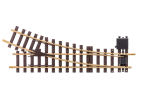I notice several of my LGB turnouts have a minor design flaw. When the switch rail is placed against the stock rail, it sticks out very slightly. This has a couple of issues:
To counter this, I was thinking about filing or grinding away a small recess in the stock rail so that the tip of the switch rail can fit entirely into it. Thus, the approaching wheel never sees the edge of the switch rail.
This will leave a slight edge on the stock rail when the point blade is open, but that shouldn't be an issue as the main profile of the rail is intact, the lip can be smoothed, and most of the pressure is away from (rather than towards) the stock rail.
Thoughts?
Any idea on the best tool for the job? I don't want to disassemble the turnout, so I basically have to get a file or rotary disc into the gap between the open switch rail and the stock rail. I also only want a very shallow indent, 0.5mm or so.
- the flanges on some of my single-axle wagons clip the switch rail, causing an uneven transition through the turnout as the flange kicks sideways off the tip of the switch rail.
- the LGB turnout drives do not "lock" after they have finished throwing. With enough vibration, the switch rails drift away from the stock rails causing derailments.
- Some third party drives lock, either mechanically or by continuing to apply trickle power after finishing their throw. Manual LGB turnout levers contain a spring mechanism that continues to apply pressure once the turnout is thrown.
To counter this, I was thinking about filing or grinding away a small recess in the stock rail so that the tip of the switch rail can fit entirely into it. Thus, the approaching wheel never sees the edge of the switch rail.
This will leave a slight edge on the stock rail when the point blade is open, but that shouldn't be an issue as the main profile of the rail is intact, the lip can be smoothed, and most of the pressure is away from (rather than towards) the stock rail.
Thoughts?
Any idea on the best tool for the job? I don't want to disassemble the turnout, so I basically have to get a file or rotary disc into the gap between the open switch rail and the stock rail. I also only want a very shallow indent, 0.5mm or so.

